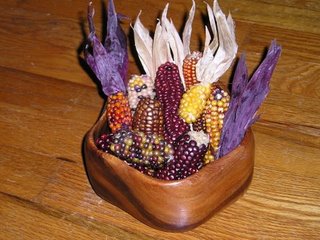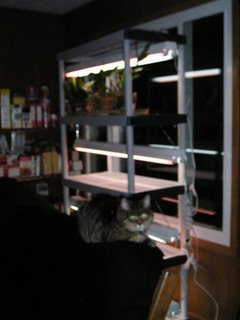Looks like winter's really here
We're just about to call it the end of this year's gardening year. The water barrels have been emptied. Might have been a good idea to do that last weekend-BEFORE the water started freezing!, but we (James) get to things as we get to them. There are chunks of ice scattered around the yard. I grabbed a few to melt in around the pomegranate. I'm sure it doesn't appreciate the cold, but we were thinking she looked like she needed a bit of water and the barrels were all emptied. . .
James's project for the weekend has been building portable 2x4 frames to support PVC hoops, over which we will stretch plastic, bird netting, or shade cloth as the season calls for it next year. Most of the frames will be built to a 4x8 foot standard size. The strawberry bed has already been built bigger than that, so we had to go buy ten foot long 2x4's for the sides of that one. Hoops will support the bird netting to protect the berries from flying competition, but I'm looking for a good solution to save some of my berries from the slimy slug-type competition! For some reason James doesn't think our neighbors would appreciate ducks, so I'm still looking. (I might be able to talk him into borrowing ducks occassionally, if anyone has a couple who would like to vacation in our yard. We do have a private pond all ready for them.) Otherwise, we'll just continue to post invitations to all the local frogs and toads, who are also supposed to consume the slimy pests.
There are very few critters I mind having in my yard. While I don't like their appearance, I'd still be okay with the slugs IF they would just leave me a few of my baby plants. One single, solitary slug gorged itself on ALL of my basil babies last spring. And I got tired of picking up beautiful bright red strawberries, only to find a hole on the other side. It was even worse when the intruder was still there devouring the berry in my hand!
Here are a picture of our harvest this year:
 This is the entire harvest of calico popcorn. It's not much, but it was very pretty sitting in this wooden bowl on our diningroom table. Very few of the late-planted corn that went up front had time to fill out the ears. I think the squirrels got a few ears, but not as many as I'd expected. James kept them satisfied dining at the platform bird feeder, where they didn't have to do the work of shucking their dinner. They preferred fill their pouches, either from the platform feeder or by stripping the kernels off of corn cobs on the squirrel feeder, and then running around the yard planting it for later consumption. You'd be amazed where we had corn growing until the freeze killed it back this week.
This is the entire harvest of calico popcorn. It's not much, but it was very pretty sitting in this wooden bowl on our diningroom table. Very few of the late-planted corn that went up front had time to fill out the ears. I think the squirrels got a few ears, but not as many as I'd expected. James kept them satisfied dining at the platform bird feeder, where they didn't have to do the work of shucking their dinner. They preferred fill their pouches, either from the platform feeder or by stripping the kernels off of corn cobs on the squirrel feeder, and then running around the yard planting it for later consumption. You'd be amazed where we had corn growing until the freeze killed it back this week.James was just building a double feeder for the squirrels, thinking that if he had three cobs of corn out at one time, they'd eat there and leave his bird feeders alone. Anyone agree? I'm guessing that they'll just invite their friends, and we'll have more squirrels to feed from the assorted feeders-and our garden next spring.
The final tally was roughly 2 cups of kernels from half a package of seed. Maybe a ten or twenty-to-one return? Not much, but it did make tasty popcorn!
Corn is a heavy feeder, and the soil probably wasn't rich enough for it this year. We'll continue soil-building, and try again in the future.
We got one lonely little acorn squash before the borers got to the vines there. The scarlet runner beans did better, and we have enough for a small pot of soup. Guess it's a good thing we're not counting on the garden to provide all of our produce yet, isn't it? ;-)
Besides the frames with hoops, to extend our growing season and protect our dinner, James is also planning trellis frames to fit on each of the boxes. I'm going to dig the asparagus bed and amend the soil (lots of leaves and manure) before the ground freezes, so we can get the crowns in early next spring. Working the soil in the fall is easier than waiting for it to dry out in the spring.
I'm also working on our seed order, and trying to figure out where we're going to plant everything. I definitely DO NOT need to order more pea seeds! We have sugar snaps, snow peas, and Oregon Giant (something?) peas-almost half a pound of each. (3,000 row feet? A slight exaggeration, but that's what it feels like at this point!) We bought plenty, intending to plant some in the late summer, for a fall crop, but I couldn't figure out where the beds we going to go, and we kept changing the plans, so I didn't get those planted. Now that it's getting cold enough that they won't germinate until the thaw, I will probably be planting part of our stash for an early spring crop. Our neighbor up the street swears by planting his peas at Christmas, so they're ready as soon as the ground warms up. The critters get a few of them, and a wet winter with lots of thawing, or a surprise late freeze, can wipe others out, but most of the time it gives them a good start. And it's certainly better than waiting until I realize that it's time to plant-especially since we've been caught up in home improvement projects the last couple of years, and have been very late getting things into the ground.
A couple of planting guidelines:
1-Corn goes in as soon as the oak leaves are the size of a squirrel's ear. (They were at least as big as a baby's hand by the time I got the Three Sisters bed planted this year. Tip: Don't plant the beans until the corn is knee-high! The corn needs a head start!)
2-We're trying potatoes next year so we need: "Plant potatoes when the dandelions bloom." Does anyone know if this applies to sweet potatoes also, or do they need to wait until it's a bit warmer?
3-Artichokes are a biennial, and don't set fruit until the second year. They can be tricked into thinking it's their second year if they are started indoors in January, growing six weeks or so for their first spring, then get moved to a cold frame for another six weeks before last frost. After that they "think" they've been through a winter, and set fruit at the end of their first summer. I get to use my growlight shelves next month!!! They do winter over in Zone 8 or south, but can supposedly make it through a mild winter in Zone 6 or 7 by cutting them back to a foot or so tall, and covering them with mulch. I'll let you know how it works-in 2008! (Okay, so I may be able to report positively on the speed-grow trick in August of 2007. . .)




